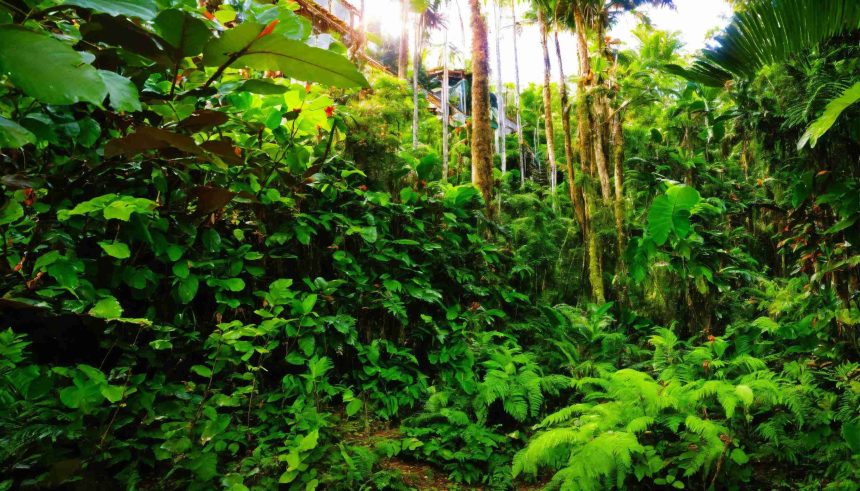A food forest, also known as an edible forest garden or a forest garden, is a low-maintenance, sustainable gardening system where you can grow a variety of delicious fruits, vegetables, and herbs while creating a beautiful ecosystem. In this article, I’ll share the basics of food forests and help you discover how you can start your own edible garden adventure.
Features of Food Forests
Food forests have several defining features that set them apart from a typical vegetable garden or orchard:
Multi-Layered Structure
Food forests consist of multiple vertical layers filled with productive plants, including:
- Canopy layer – This top layer is comprised of large nut and fruit trees like walnuts, chestnuts, apples, pears and plums.
- Understory layer – Smaller fruit trees, bushes and shrubs like currants, gooseberries and hazelnuts occupy this layer.
- Shrub layer – The shrub layer contains productive plants like blueberries, raspberries and culinary herbs.
- Herbaceous layer – Shade-tolerant crops, including greens, vegetables, medicinal herbs and edible flowers grow here.
- Rhizosphere/Ground cover – Dynamic accumulators, ground cover crops and fungi thrive in this bottom layer.
- Vertical layer – Vining and climbing crops like grapes, kiwi and passionfruit propagate vertically between layers.
Diversity of Species
A key principle of food forests is increased diversity, which promotes greater resilience and health. They incorporate a wide variety of mutually beneficial edible, medicinal and resource plants.
Self-Sustaining Ecosystem
Once established, food forests require very little maintenance. The plants selected create a balanced ecosystem where each element contributes to the health and productivity of the whole system.
How Do Food Forests Work?
Food forests are intentionally designed to replicate woodland ecosystems. Every component plays a role in maintaining the health and vitality of the whole:
Dynamic Accumulators & Nutrient Cycling
Certain plants like comfrey and nasturtiums are included for their ability to draw up nutrients from the soil depths, making them available to other plants. Chopped leaves and stalks are used as nutritious mulch, facilitating effective nutrient cycling.
Natural Pest Control
A wide range of beneficial insects and pollinators are attracted by the diversity of flowering and nesting habitat. Predatory insects control more harmful species, reducing the need for intervention.
Efficient Water Usage
The multiple layers protect the soil from drying winds and sun. Deep and extensive root systems retain moisture and cycle nutrients back to top layers. Less watering is required after the system matures.
Increased Resilience
Greater genetic, species and structural complexity leads to enhanced health and resilience. Food forests tend to avoid large-scale pest infestations, blights and crop failures that can devastate monocultures.
Benefits of Food Forests
Intentionally designed food forests offer many benefits:
| Low Maintenance | Once established, very little effort is required to maintain productivity. Dense planting reduces the need for watering and weeding. The enhanced soil life suppresses most weeds naturally. |
| Increased Yields | By maximizing space with vertical layers, overall productivity per square foot is greatly boosted compared with conventional plots. More varied niches also extend seasonal availability of harvests. |
| Environmental Conservation | Food forests conserve energy, water and soil health while sequestering carbon. The enhanced biodiversity also provides wildlife habitat to support threatened pollinators, birds and beneficial insects. |
| Community Building | Public and community food forests provide free access to nutritious food while creating opportunities for education, recreation and neighborhood connections. |
| Climate Resilience | Diverse ecosystems handle environmental stressors like floods, droughts and extreme weather much better than monocultures. They may play an important role in community adaptation to climate change. |
Elements of Food Forest Design
Creating a successful, thriving food forest requires thoughtfully incorporating certain design elements:
Species Selection
Choose productive trees, shrubs, vines, herbs and fungi with overlapping functions and growth habits that work synergistically. Prioritize native, resilient and well-adapted varieties.
Structural Design
Mimic natural forest structure with dynamic vertical stratification and density over time. Map anticipated height and width of key species when mature.
Ecological Design
Understand sun exposure, drainage, water flows, soil types, wind patterns and other existing dynamics. Select plants suited to each unique microclimate and position them appropriately.
Integrated Water Management
Incorporate swales, ponds, berms and channels to control and retain rainwater on site, maximizing passive irrigation and groundwater recharge. Choose drought-tolerant varieties.
Enhancing Soil Health
Continually feed and promote complex soil ecology through chop-and-drop pruning, dense planting, nutrient accumulators, fungi inoculation, compost layers and thick organic mulch.
Facilitating Positive Interactions
Choose mutually beneficial plants that enhance one another’s growth and vitality via symbiotic relationships. For example, planting bee-friendly flowers near fruit trees.
Planning for All Needs
Consider functional roles, aesthetics, microclimates, maintenance, harvesting, community benefits and more when planning the garden. Strive to create an abundant ecosystem meeting many needs sustainably.
How to Start a Food Forest
If learning about food forests has you ready start your own forest garden, follow these general guidelines:
Study Food Forest Gardening Extensively
Read books, take workshops and investigate local examples to build essential knowledge before breaking ground. This complex methodology differs greatly from traditional gardening.
Analyze Your Site Conditions
Survey your site to identify soil types, sun exposure, wind patterns, vulnerabilities, erosion risks and more across different areas. Note these on a site map.
Design Thoughtfully on Paper First
Use your site survey details to thoughtfully design the garden’s layout on paper first. Sketch beds, water elements, paths, structures and planting areas to scale.
Install Necessary Infrastructure
Before planting, install required structural enhancements like shade arbors, rainwater irrigation, drainage systems, pathways, protective fencing and garden beds.
Plant Seedlings & Seeds
Once infrastructure is set, plant seedlings and seeds of chosen species in appropriate locations based on sunlight, moisture and symbiotic relationships.
Maintain & Adapt As Needed
Monitor your food forest ecosystem. Prune, mulch and amend soil as needed in early seasons. Observe interactions and adapt species mixes over time if necessary.
Example Food Forest Plants
These are just a small sampling of the many species suitably incorporated into food forests:
- Canopy Trees: Chestnut, Breadfruit, Mulberry, Pawpaw, Pecan, Walnut, Almond, Mango, Jackfruit, Fig
- Understory Trees: Pineapple Guava, Banana, Papaya, Lemon, Lime, Orange, Crabapple, Plum, Peach, Nectarine
- Shrubs & Vines: Goji Berry, Honeyberry, Blueberry, Elderberry, Currant, Gooseberry, Grape, Kiwi, Passionfruit, Goumi
- Herbaceous Plants: Asparagus, Artichoke, Beet, Carrot, Garlic, Ginger, Jerusalem artichoke, Oca, Onion, Potato, Sweet Potato, Turmeric, Yacon
- Edibles: Amaranth, Arugula, Bok Choy, Chard, Chickweed, Chicory, Dandelion, Dock, Malabar Spinach, Purslane, Radish, Sorrel, Spinach, Strawberry
- Soil & Nutrients: Burdock, Chickweed, Chilean Mesquite, Chicory, Comfrey, Dill, Fennel, Marigold, Mustard, Nasturtium, Stinging Nettle, White Clover, Yarrow
- Medicinal Herbs: Aloe Vera, Calendula, Chamomile, Echinacea, Fenugreek, French Tarragon, Lavender, Lemon Balm, Milk Thistle, Peppermint, Sage, St. John’s Wort, Thyme
Optimal Conditions for Food Forests
Food forests can and have been planted successfully across widely varying climates and terrains. However, these general conditions tend to provide the highest chance of success:
- Adequate moderate rainfall (25-45 inches annually) with supplemental irrigation systems
- Frost-free or mild winters
- Well-drained, loamy soils high in organic matter
- Full sun to partial shade exposure
- Protection from strong winds
- Flat or gently sloping terrain
Even challenging sites can support vibrant food forests with careful design adaptations like drought-tolerant plant varieties, microclimate modifications and erosion barriers. Those in very cold winter climates may opt for an annual “forest garden” model.
FAQs
Food forests can be created even in small spaces like backyards. However, it’s ideal to have at least 0.1-0.5 acre to allow enough space for trees and a diverse ecosystem.
Most productive food forests need full sun to partial shade, ideally 6 hours or more of direct sun daily. Shade tolerant plants can fill in the understory areas.
Costs vary significantly based on size and components included, but often range $3,000- $4,000 to establish for a small to medium home food forest. Larger community forests carry higher costs.
It takes roughly 5-10 years for food forest ecosystems to mature, depending on the size/density of plantings. Some annual crops and berries produce earlier than tree crops.
Relative to square footage, food forests can produce estimated yields up to 20 times higher than traditional vegetable gardens over time by utilizing vertical space.
Once established, very little maintenance is needed if designed well. Main tasks involve pruning, occasional amendments and harvesting productive plants.
Food forests should be designed to retain moisture onsite as much as possible. Swales, berms, rain catchment and dense plantings all help reduce water needs long-term.
Conclusion
Food forests are abundant ecosystems modeled after woodlands and designed to provide ongoing yields of food and botanical resources with minimal maintenance. These multi-layered gardens offer many environmental and community benefits when thoughtfully planted and tended using permaculture principles. Their lush beauty and promise of food security even on small sites will likely continue attracting converts to forest gardening practices long into the future.




